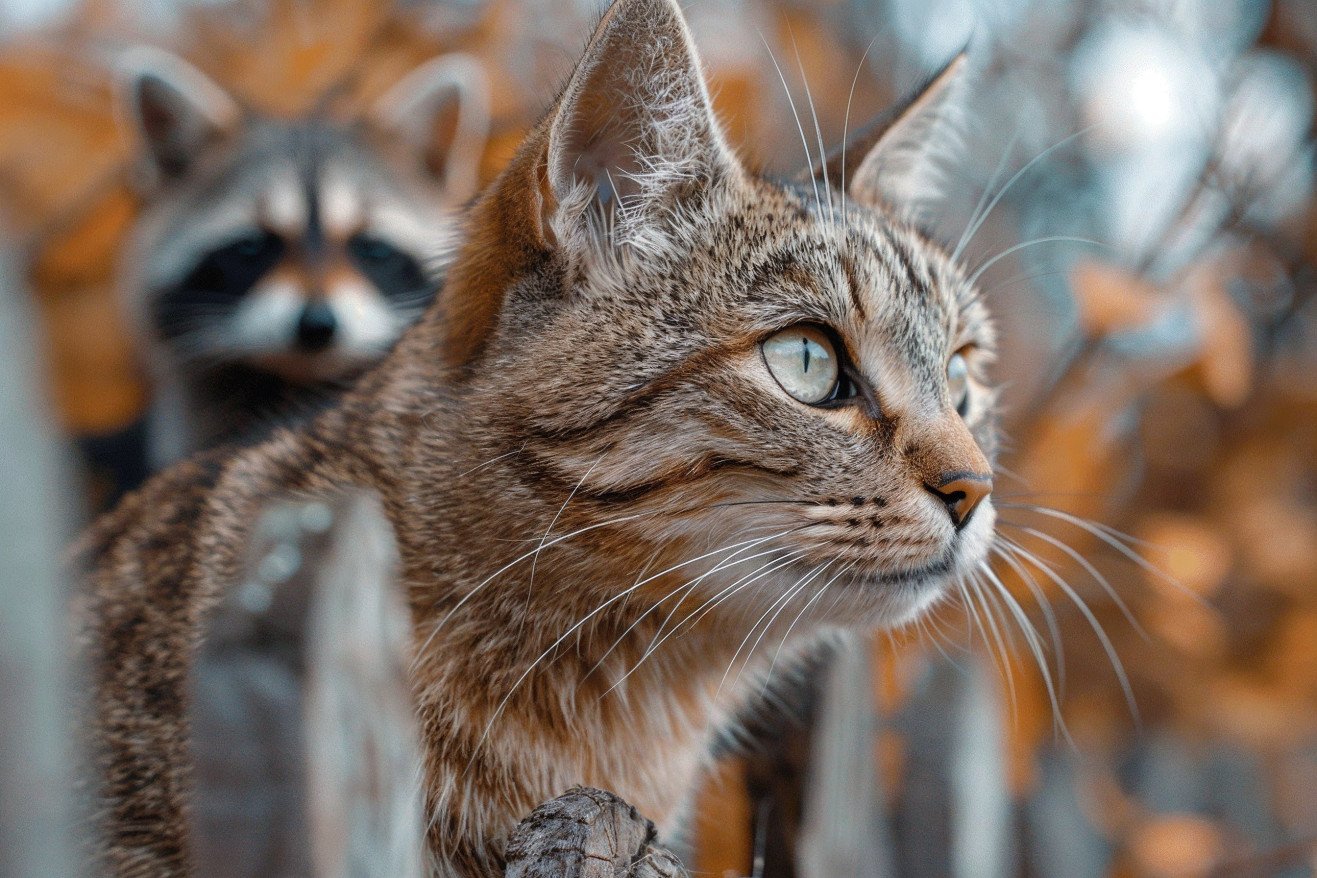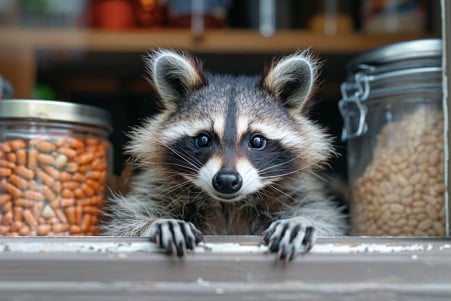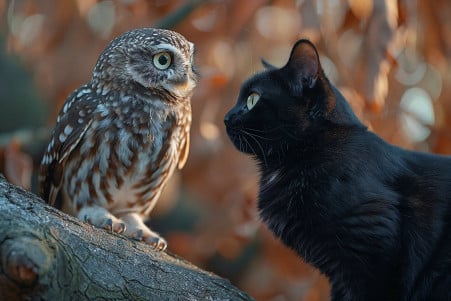Do Raccoons Kill Cats? Understanding the Risk and Protective Measures
3 March 2024 • Updated 2 March 2024

Raccoons, which are often thought of as sneaky, may be a threat to the lives of neighborhood cats, but how likely is that to happen? While raccoons will generally steer clear of adult cats, they may attack kittens or small cats if they are hungry or feel threatened, especially if they are protecting their young. That said, the threat of raccoons preying on cats is low, as raccoons tend to avoid predatory behavior.
This article will explore ecological research, behaviorist theory, and urban wildlife studies to provide a comprehensive understanding of the nuanced relationship between raccoons and house cats. It will also outline the circumstances under which raccoons may be dangerous and offer suggestions for keeping cats safe. By examining this research from multiple fields, you will gain a better understanding of the risks to your pets and how to keep them out of harm’s way.
Do raccoons kill cats?
Coexistence and Conflict: Raccoon and Cat Dynamics
The relationship between raccoons and cats is largely one of coexistence. According to Skedaddle Humane Wildlife Control, the two species tend to be indifferent to one another, and most interactions are non-confrontational. Because cats are smaller and less of a threat to raccoons, the two animals tend to coexist peacefully.
That said, there are some situations in which conflict can arise. For example, competition for resources like outdoor cat food can lead to conflict.
Raccoons are attracted to cat food and can spread diseases like feline distemper and roundworms to cats when they come into contact with it, according to Pets The Nest. Mother raccoons can also be aggressive when defending their young, which can put small cats and kittens in the area at risk.
While there are documented cases of raccoons attacking small kittens, these incidents are rare and are usually the result of specific circumstances like the defense of offspring or a lack of resources rather than an inherent predatory drive.
To avoid problems, experts recommend keeping cats indoors at night, making sure they’re vaccinated, and not leaving food out that could attract raccoons. By understanding these dynamics and taking steps to prevent conflict, the risk of raccoon attacks on cats can be significantly reduced.
Why Do Raccoons Act Aggressively?
Raccoons are solitary animals and their behavior is largely driven by territorial instincts. As a result, raccoons will defend their territory to ensure they have access to food and shelter. This is especially true during mating season, which occurs in late winter or early spring. In addition, a mother raccoon will protect her young, and this often results in violent interactions with other animals, including occasional run-ins with domestic cats.
In addition to territorial and maternal aggression, raccoons can also act aggressively when they are sick. For example, Skedaddle Wildlife Control explains that diseases like rabies can lead to unpredictable aggression in raccoons. This is especially concerning because raccoons with rabies can not only infect other wildlife but also pets.
The relationship between raccoons and other animals is further complicated by human behavior. For example, the Humane Society of the United States explains that our manipulation of the environment, such as leaving out trash or pet food, can lead to raccoon aggression by creating conflict over resources.
As we continue to live alongside these nocturnal animals, it’s important to understand the different causes of raccoon aggression so we can help protect our cats from potential harm.
The Science of Cat Fighting
Cats have a variety of defensive tools at their disposal when it comes to dealing with predators such as raccoons. Their aggression may be driven by fear, pain, or territoriality, and the signs of aggression in cats are often quite obvious, according to the Cornell University College of Veterinary Medicine.
When a cat feels threatened, their ears will flatten, their pupils will dilate, and their tail will either puff up or tuck between their legs, according to PetMD and the ASPCA. These are all signs that a cat will use to try to scare off a potential attacker.
Cats’ speed and agility also help them get away from predators quickly. Cats’ claws and teeth are not only used for hunting but also for self-defense in situations like this.
While a cat’s physical abilities can help them escape a predator, their ability to recognize danger and get away from it is even more important. Cats that are especially agile and aware can often fend off raccoons. However, smaller cats and kittens are especially vulnerable due to their size and relative lack of strength.
Recognizing these natural defense mechanisms is important when it comes to understanding why it’s so important to protect cats from outside threats, including those from wildlife that can carry disease.
The Hidden Dangers: Disease Transmission and Raccoon-Cat Encounters
Raccoons carry a number of diseases that can be dangerous to cats, including rabies and Baylisascaris procyonis, the raccoon roundworm. Both Wag and PetMD note that the diseases that raccoons carry can cause severe neurological symptoms in cats, including lethargy and incoordination, due to the migration of roundworm larvae, and in extreme cases, even result in a coma.
Not only can these health problems lead to more frequent encounters with raccoons, but they can also make cats more susceptible to or more likely to initiate conflicts with raccoons.
Preventative measures are key to minimizing these dangers. The CDC and AVMA advise that cats be kept indoors to prevent them from being exposed to contaminated areas and that cats be dewormed regularly to protect them from the raccoon roundworm.
If a cat does come into contact with a raccoon that may be infected with a disease, the cat’s owner should consult their veterinarian immediately. By removing potential raccoon latrines and food sources, we can reduce the risk of disease transmission, make coexisting with wildlife safer, and ensure our cats’ safety.
Urban Adaptation: Raccoons and the Implications for Domestic Cats
Raccoons are one of the most successful urban adapters and are thriving in urban environments. In fact, a study in the Canadian Journal of Zoology found that raccoon density in urban national parks is much higher than in rural areas, leading to concerns about pet safety. By adapting to human-dominated landscapes and using garbage as a food source, raccoons have increasingly come into contact with domestic animals, including cats.
The intelligence of raccoons, which has been shown in both scientific research and personal stories, has helped them overcome the challenges of living in urban areas, according to Slate. This intelligence, combined with a high population density—211 raccoons per square kilometer in urban parks compared to 9 in forested areas, according to CBC News—makes it more likely that pets will encounter raccoons in urban areas.
Responsible pet ownership and wildlife management are key to reducing these encounters. Wildlife management solutions include securing garbage to limit raccoons’ food sources, keeping cats indoors at night, and installing raccoon-proof cat doors. These solutions are necessary to avoid conflicts and ensure the safety of our pets in the face of increasing urban raccoon populations.
Key Takeaways: What We Know About Raccoons Killing Cats
In the complex world of urban wildlife, the risk of raccoons killing cats is low, but it does exist. Protective behavior, territorial conflicts, and competition for resources are the most common reasons for these rare occurrences. To help prevent these conflicts and keep our pets safe, it’s important to understand the behavior of raccoons and cats.
One of the most important things to understand is the role of disease. Because raccoons can spread diseases to cats, responsible pet ownership, including vaccinations and keeping cats indoors, is important for keeping them safe. With awareness and action, we can greatly reduce the risk of wildlife-related health issues.
It is evident that living with wildlife in urban areas and understanding the relationship between raccoons and cats requires a community approach and ongoing education. Working toward more research and knowledge will help us create a peaceful relationship that values the well-being of all of our urban residents, whether they are wild or domesticated.


